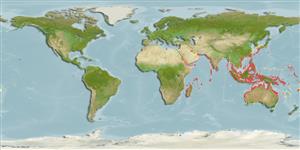Malacostraca |
Decapoda |
Diogenidae
Environment: milieu / climate zone / depth range / distribution range
Ecology
Benthic; brackish. Tropical
Indo-West Pacific.
Length at first maturity / Size / Weight / Age
Maturity: Lm ? range ? - ? cm
Very common in mangrove areas (Ref. 81754). Estuarine or brackish, intertidal (Ref. 106854). Feeds by means of both micro and macrofeeding. That is, it filter feeds, trapping microorganisms. It deposit feeds, utilizing detritus. As macrofeeder, it mainly depends on green algae, barnacles and worms (Ref. 108395). Discretely motile (Ref. 125928).
Life cycle and mating behavior
Maturity | Reproduction | Spawning | Eggs | Fecundity | Larvae
Members of the order Decapoda are mostly gonochoric. Mating behavior: Precopulatory courtship ritual is common (through olfactory and tactile cues); usually indirect sperm transfer.
Rahayu, D.L. 2000. (Ref. 81753)
IUCN Red List Status (Ref. 130435)
CITES status (Ref. 108899)
Not Evaluated
Not Evaluated
Threat to humans
Harmless
Human uses
| FishSource |
Tools
More information
Age/Size
Growth
Length-weight
Length-length
Morphology
Larvae
Abundance
Internet sources
Estimates based on models
Preferred temperature
(Ref.
115969): 24.7 - 29.2, mean 28.5 (based on 1727 cells).
